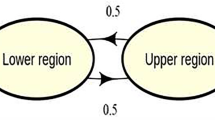Abstract
Predator–prey interactions are among the most complicated interactions between biological species, in which there may be both direct effect (through predation) and indirect effect (e.g., fear effect). In the literature, the indirect effect has been largely missing in predator–prey models, until some recent works. Based on the recent work (Wang et al. in J Math Biol 73:1179–1204, 2016) where a fear effect is considered in an ODE model as a cost, in this paper, we also consider a benefit from the anti-predation response in addition to the cost, as well as a time delay in the transfer of biomass from the prey to the predator after predation. This results in a system of delay differential equations (DDEs). By analyzing this nonlinear DDE system, we obtain some insights on how the anti-predation response level (indirect effect) and the biomass transfer delay jointly affect the population dynamics; particularly we show how the nonlinearity in the predation term mediated by the fear effect affects the long term dynamics of the model system. We also perform some numerical computations and simulations to demonstrate our results. These results seem to suggest a need to revisit existing predator–prey models in the literature by incorporating the indirect effect and biomass transfer delay.










Similar content being viewed by others
References
Abrams, P.A., Ginzburg, L.R.: The nature of predation: Prey dependent, ratio dependent or neither? Trends Ecol. Evol. 15, 337–341 (2000)
Arditi, R., Ginzburg, L.R.: Coupling in predator–prey dynamics: ratio dependence. J. Theor. Biol. 139, 311–326 (1989)
Castillo-Chavez, C., Thieme, H.R.: Asymptotically autonomous epidemic models. In: Arino, O., et al. (eds.) Mathematical Population Dynamics: Analysis of Heterogeneity, I. Theory of Epidemics, pp. 33–50. Wuerz, Winnipeg (1995)
Creel, S., Christianson, D.: Relationships between direct predation and risk effects. Trends Ecol. Evol. 23, 194–201 (2008)
Cresswell, W.: Predation in bird populations. J. Ornithol. 152, 251–263 (2011)
Cushing, J.M.: Integro-Differential Equations and Delay Models in Population Dynamics. Lecture Notes in Biomathematics, vol. 20. Springer, Berlin (1977)
Das, A., Samanta, G.P.: Modeling the fear effect on a stochastic prey–predator system with additional food for the predator. J. Phys. A Math. Theor. 51, 465601 (2018)
Hale, J.K., Lunel, S.M.V.: Introduction to Functional Differential Equations. Springer, New York (1993)
Hayes, N.D.: Roots of the transcendental equations associated with a certain differential-difference equation. J. Lond. Math. Soc. 25, 226–232 (1950)
Holling, C.S.: The functional response of predator to prey density and its role in mimicry and population regulation. Mem. Entomol. Soc. Can. 45, 1–60 (1965)
Jeschke, J.M., Kopp, M., Tollrian, R.: Predator function responses: discriminating between handling and digesting prey. Ecol. Monogr. 72(1), 95–112 (2002)
Li, F., Li, H.: Hopf bifurcation of a predator–prey model with time delay and stage structure for the prey. Math. Comput. Model. 55, 672–679 (2012)
Lima, S.L.: Nonlethal effects in the ecology of predator–prey interactions. Bioscience 48, 25–34 (1998)
Lima, S.L.: Predators and the breeding bird: behavioural and reproductive flexibility under the risk of predation. Biol. Rev. 84, 85–513 (2009)
Lotka, A.J.: Analytical note on certain rhythmic relations in organic systems. Proc. Natl. Acad. Sci. U.S.A. 6, 410–415 (1920)
Lotka, A.J.: Elements of Physical Biology. Williams and Wilkins, Philadelphia (1925)
Mondal, S., Maiti, A., Samanta, G.P.: Effects of fear and additional food in a delayed predator–prey model. Biophys. Rev. Lett. 13, 157–177 (2018)
Rosenzweig, M.L., MacArthur, R.H.: Graphical representation and stability conditions of predator–prey interactions. Am. Nat. 97, 209–223 (1963)
Skalski, G.T., Gilliam, J.F.: Functional responses with predator interference: viable alternatives to the Holling type II model. Ecology 82, 3083–3092 (2001)
Smith, H.: Monotone Dynamical Systems: An Introduction to the Theory of Competitive and Cooperative Systems. Mathematical Surveys and Monographs, vol. 41. American Mathematical Society, Providence (1995)
Smith, H.: An Introduction to Delay Differential Equations with Applications to the Life Sciences. Springer, New York (2010)
Volterra, V.: Variazioni e fluttuazioni del numero d’individui in specie animali conviventi. Mem. Acad. Lincei Roma 2, 31–113 (1926)
Volterra, V.: Variations and fluctuations of the number of individuals in animal species living together. In: Chapman, R.N. (ed.) Animal Ecology. McGraw-Hill, New York (1931)
Wang, X., Zou, X.: Modeling the fear effect in predator–prey interactions with adaptive avoidance of predators. Bull. Math. Biol. 79, 1325–1359 (2017)
Wang, X., Zou, X.: Pattern formation of a predator–prey model with the cost of anti-predator behaviours. Math. Biosci. Eng. 15, 775–805 (2018)
Wang, X., Zanette, L.Y., Zou, X.: Modelling the fear effect in predator–prey interactions. J. Math. Biol. 73, 1179–1204 (2016)
Wangersky, P.J., Cunningham, W.J.: Time lag in prey–predator population models. Ecology 38, 136–139 (1957)
Xu, R.: Global dynamics of a predator-prey model with time delay and stage structure for the prey. Nonlinear Anal. RWA 12, 2151–2162 (2011)
Zanette, L.Y., White, A.F., Allen, M.C., Clinchy, M.: Perceived predation risk reduces the number of offspring songbirds produce per year. Science 334(6061), 1398–1401 (2011)
Author information
Authors and Affiliations
Corresponding author
Additional information
Communicated by Sue Ann Campbell.
Publisher's Note
Springer Nature remains neutral with regard to jurisdictional claims in published maps and institutional affiliations.
Research partially supported by NSERC of Canada (RGPIN-2016-04665).
Rights and permissions
About this article
Cite this article
Wang, Y., Zou, X. On a Predator–Prey System with Digestion Delay and Anti-predation Strategy. J Nonlinear Sci 30, 1579–1605 (2020). https://doi.org/10.1007/s00332-020-09618-9
Received:
Accepted:
Published:
Issue Date:
DOI: https://doi.org/10.1007/s00332-020-09618-9




